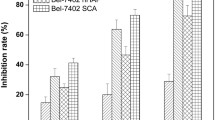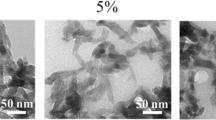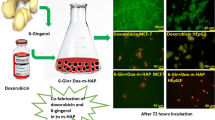Abstract
Hydroxyapatite nanoparticles have been reported to exhibit potent anti-tumor effects in some cancer cells. In our previous study, we have successfully synthesized two types of hydroxyapatite nanoparticles, laminated hydroxyapatite (L-HAp) and laminated magnetic hydroxyapatite (LM-HAp). In this study, we wanted to investigate the effects of L-HAp and LM-HAp with various concentrations on human breast cancer MDA-MB-231 cells. Cell proliferation was assessed with a MTT colorimetric assay. Scratch and adhesion assays were used to detect the effects of these two materials on migration and adhesion. The expressions of integrin β1 and Akt were measured by Western blotting. Our results showed that L-HAp and LM-HAp had little cell cytotoxicity and significantly reduced cell mobility and adhesion. LM-HAp showed greater inhibitor ability on migration and adhesion of MDA-MB-231 cells. Moreover, results from western blotting showed that L-HAp and LM-HAp impacted the phosphorylation of integrin β1, but showed no regular impact on Akt. This study suggests that L-HAp and LM-HAp may be potential anti-tumor and delivery system for breast cancer therapy.





Similar content being viewed by others
References
Gupta GP, Massagué J. Cancer metastasis: building a framework. Cell. 2006;127:679–95.
Hirohashi S. Inactivation of the E-cadherin-mediated cell adhesion system in human cancers. Am J Pathol. 1998;153:333–9.
Du C, Cui FZ, Zhu XD, de Groot K. Three-dimensional nano-HAp/collagen matrix loading with osteogenic cells in organ culture. J Biomed Mater Res. 1999;44:407–15.
Wan YZ, Hong L, Jia SR, Huang Y, Zhu Y, Wang YL, et al. Synthesis and characterization of hydroxyapatite-bacterial cellulose nanocomposites. Compos Sci Technol. 2006;66:1825–32.
Wei GB, Ma PX. Structure and properties of nano-hydroxyapatite/polymer composite scaffolds for bone tissue engineering. Biomaterials. 2004;25:4749–57.
Zhang RY, Ma PX. Poly(alpha-hydroxyl acids) hydroxyapatite porous composites for bone-tissue engineering. I. Preparation and morphology. J Biomed Mater Res. 1999;44:446–55.
Matsumoto T, Okazaki M, Inoue M, Yamaguchi S, Kusunose T, Toyonaga T, et al. Hydroxyapatite particles as a controlled release carrier of protein. Biomaterials. 2004;25:3807–12.
Palazzo B, Iafisco M, Laforgia M, Margiotta N, Natile G, Bianchi CL, et al. Biomimetic hydroxyapatite-drug nanocrystals as potential bone substitutes with antitumor drug delivery properties. Adv Funct Mater. 2007;17:2180–8.
Yang P, Quan Z, Li C, Kang X, Lian H, Lin J. Bioactive, luminescent and mesoporous europium-doped hydroxyapatite as a drug carrier. Biomaterials. 2008;29:4341–7.
Wu GJ, Zhou LZ, Wang KW, Chen F, Sun Y, Duan YR, et al. Hydroxylapatite nanorods: an efficient and promising carrier for gene transfection. J Colloid Interface Sci. 2010;345:427–32.
Meena R, Kesari KK, Rani M, Paulraj R. Effects of hydroxyapatite nanoparticles on proliferation and apoptosis of human breast cancer cells (MCF-7). J Nanopart Res. 2012;14:712.
Chen X, Deng C, Tang S, Zhang M. Mitochondria-dependent apoptosis induced by nanoscale hydroxyapatite in human gastric cancer SGC-7901 cells. Biol Pharm Bull. 2007;30:128–32.
Liu ZS, Tang SL, Ai ZL. Effects of hydroxyapatite nanoparticles on proliferation and apoptosis of human hepatoma BEL-7402 cells. World J Gastroenterol. 2003;9:1968–71.
Zuo GF, Wan YZ, Meng XG, Zhao Q, Ren K, Jia S, et al. Synthesis and characterization of a lamellar hydroxyapatite/DNA nanohybrid. Mater Chem Phys. 2011;126:470–5.
Zuo GF, Wan YZ, Zhang Y. Preparation and characterization of a novel laminated magnetic hydroxyapatite for application on gene delivery. Mater Lett. 2012;68:225–7.
Kaczarek E, Zapf S, Bouterfa H, Tonn JC, Westphal M, Giese A. Dissecting glioma invasion: interrelation of adhesion, migration and intercellular contacts determine the invasive phenotype. Int J Dev Neurosci. 1999;17:625–41.
Doerr ME, Jones JI. The roles of integrins and extracellular matrix proteins in the insulin-like growth factor I-stimulated chemotaxis of human breast cancer cells. J Biol Chem. 1996;271:2443–7.
Yuan Y, Liu C, Qian J, Wang J, Zhang Y. Size-mediated cytotoxicity and apoptosis of hydroxyapatite nanoparticles in human hepatoma HepG2 cells. Biomaterials. 2010;31:730–40.
Ananthakrishnan R, Ehrlicher A. The forces behind cell movement. Int J Biol Sci. 2007;3:303–17.
Collective Rorth P, Migration Cell. Annu Rev Cell Dev Biol. 2009;25:407–29.
Lefranc F, Brotchi J, Kiss R. Possible future issues in the treatment of glioblastomas: special emphasis on cell migration and the resistance of migrating glioblastoma cells to apoptosis. J Clin Oncol. 2005;23:2411–22.
Fong YC, Liu SC, Huang CY, Li TM, Hsu S-F, Kao S-T, et al. Osteopontin increases lung cancer cells migration via activation of the alpha v beta 3 integrin/FAK/Akt and NF-kappa B-dependent pathway. Lung Cancer. 2009;64:263–70.
Zhou GL, Zhuo Y, King CC, Fryer BH, Bokoch GM, Field J. Akt phosphorylation of serine 21 on Pak1 modulates Nck binding and cell migration. Mol Cell Biol. 2003;23:8058–69.
Yang JX, Tang WL, Wang XX. Superparamagnetic iron oxide nanoparticles may affect endothelial progenitor cell migration ability and adhesion capacity. Cytotherapy. 2010;12:251–9.
Acknowledgments
This work is supported by the National Natural Science Foundation of China (Grants No. 51172158 and 81200663), the Science and Technology Support Program of Tianjin (Grant No. 11ZCKFSY01700) and the Natural Science Foundation of Hebei Province (Grants No. E2014209204).
Author information
Authors and Affiliations
Corresponding author
Rights and permissions
About this article
Cite this article
Jin, J., Zuo, G., Xiong, G. et al. The inhibition of lamellar hydroxyapatite and lamellar magnetic hydroxyapatite on the migration and adhesion of breast cancer cells. J Mater Sci: Mater Med 25, 1025–1031 (2014). https://doi.org/10.1007/s10856-013-5126-8
Received:
Accepted:
Published:
Issue Date:
DOI: https://doi.org/10.1007/s10856-013-5126-8




